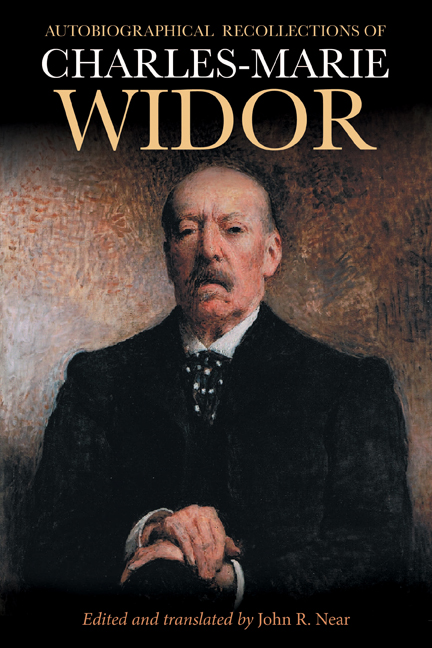Book contents
- Frontmatter
- Contents
- List of Illustrations
- Foreword
- Preface
- Acknowledgments
- Introduction: Tribute to Charles-Marie Widor
- Part One Studies, Early Performances, and Aristide Cavaillé-Coll (1844–69)
- Part Two La Belle Époque: The Franco-Prussian War to The Great War (1870–1914)
- Part Three The Great War and Important Initiatives (1914–37)
- Appendix 1 Birth record of Charles-Marie Widor, 1844
- Appendix 2 Widor’s Diplôme de Bachelier ès Lettres, 1863
- Appendix 3 Widor’s letter of appreciation to Jacques Lemmens, 1863
- Appendix 4 Brussels Ducal Palace organ specification, 1861
- Appendix 5 Widor’s certificate for Chevalier de l’Ordre du Christ, 1866
- Appendix 6 “To Budapest,” 1893
- Appendix 7 Widor’s travels to Russia and his 1903 passport
- Appendix 8 Widor’s list of his works in 1894
- Appendix 9 The Paris Conservatory organs, 1872
- Appendix 10 Chronique [Widor’s appeal for an organ hall at the Paris Conservatory, 1895]
- Appendix 11 Widor’s certificate for the Académie Royale, Brussels, 1908
- Appendix 12 “Debussy & Rodin,” 1927
- Appendix 13 The American Conservatory organ, Fontainebleau, 1925
- Appendix 14 Letters concerning the Trocadéro organ restoration, 1926
- Notes
- Bibliography
- Index
- Eastman Studies in Music
47 - 1921: The American Conservatory at Fontainebleau
Published online by Cambridge University Press: 09 May 2024
- Frontmatter
- Contents
- List of Illustrations
- Foreword
- Preface
- Acknowledgments
- Introduction: Tribute to Charles-Marie Widor
- Part One Studies, Early Performances, and Aristide Cavaillé-Coll (1844–69)
- Part Two La Belle Époque: The Franco-Prussian War to The Great War (1870–1914)
- Part Three The Great War and Important Initiatives (1914–37)
- Appendix 1 Birth record of Charles-Marie Widor, 1844
- Appendix 2 Widor’s Diplôme de Bachelier ès Lettres, 1863
- Appendix 3 Widor’s letter of appreciation to Jacques Lemmens, 1863
- Appendix 4 Brussels Ducal Palace organ specification, 1861
- Appendix 5 Widor’s certificate for Chevalier de l’Ordre du Christ, 1866
- Appendix 6 “To Budapest,” 1893
- Appendix 7 Widor’s travels to Russia and his 1903 passport
- Appendix 8 Widor’s list of his works in 1894
- Appendix 9 The Paris Conservatory organs, 1872
- Appendix 10 Chronique [Widor’s appeal for an organ hall at the Paris Conservatory, 1895]
- Appendix 11 Widor’s certificate for the Académie Royale, Brussels, 1908
- Appendix 12 “Debussy & Rodin,” 1927
- Appendix 13 The American Conservatory organ, Fontainebleau, 1925
- Appendix 14 Letters concerning the Trocadéro organ restoration, 1926
- Notes
- Bibliography
- Index
- Eastman Studies in Music
Summary
The American Conservatory of Fontainebleau lasted successfully until the American crisis. As most of the boarders were supported by scholarships, the school was in jeopardy when these scholarships were stopped.
In the aftermath of the Armistice, the American government thought: “We cannot repatriate all our nationals. What do we do with these young people, many of whom were destined for an artistic career?” We had started to found a school of painting and sculpture in Meudon that operated for a season, and we realized that there were also other artists: musicians. It was then, with Saint-Saëns and Walter Damrosch, that we founded the Fontainebleau School [in 1921]. Why Fontainebleau? Because the premises, which had served as a hospital during the war, had been cleaned, refurbished, and were vacant. They could therefore accommodate a conservatory.
An organ was built for the former room of the Jeu de Paume. Most of the study rooms were the former apartments of court guests; the parquet floor is magnificent. This school was a delight for a few years until, alas, the crisis occurred. It currently remains in a reduced state, but we hope that a day will come in better times when it will regain its former vitality. The Conservatory was doubled by an American art school of which Jacques Carlu was the director; it included a painting section and a sculpture section.
I resigned two years ago [1934] when the number of students became completely insufficient. Most of the local citizens of Fontainebleau were quite interested in the Conservatory. They were very high-class, which could be judged by the elegant audiences that flocked to the Thursday concerts in the hall of the Jeu de Paume. I personally went every week to listen to the organists, and to give them a general course in composition and on Bach's works and the appropriate style to maintain for him. We had some very beautiful concerts. Of course, the admission to these concerts was free and always by invitation, since it's never allowed to charge entrance fees to national palaces. We had asked in vain for permission to take up a collection in favor of the Sisters of Saint-Vincent-de-Paul and the poor, but it was impossible. The administration refused.
- Type
- Chapter
- Information
- Autobiographical Recollections of Charles-Marie Widor , pp. 91 - 92Publisher: Boydell & BrewerPrint publication year: 2024

